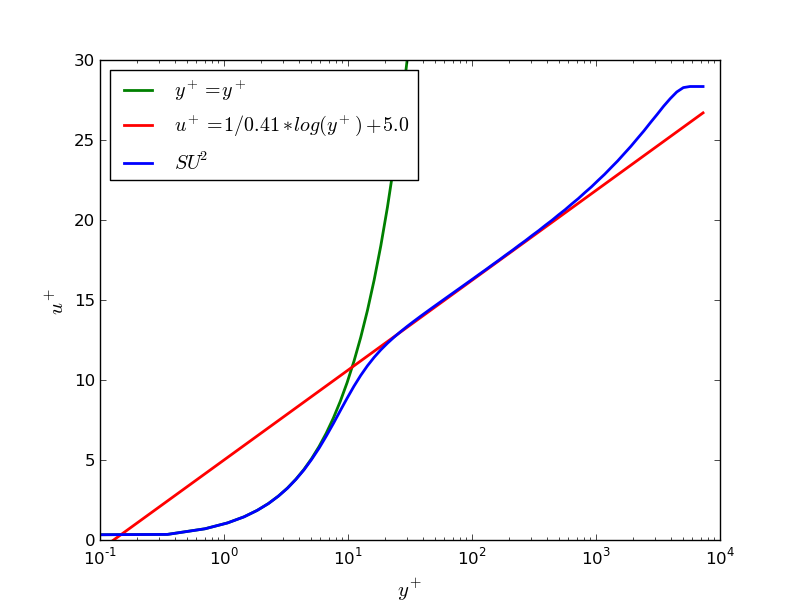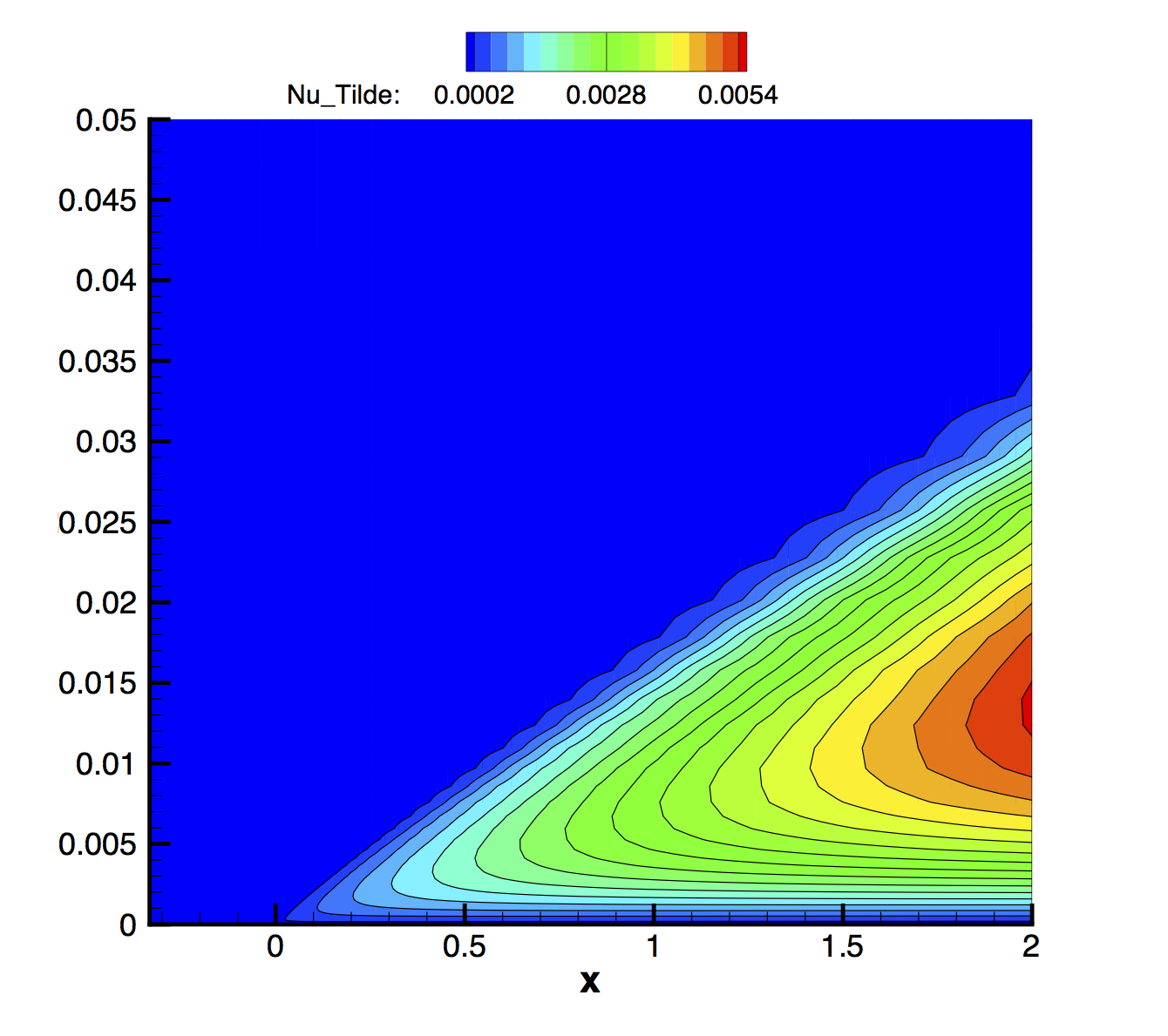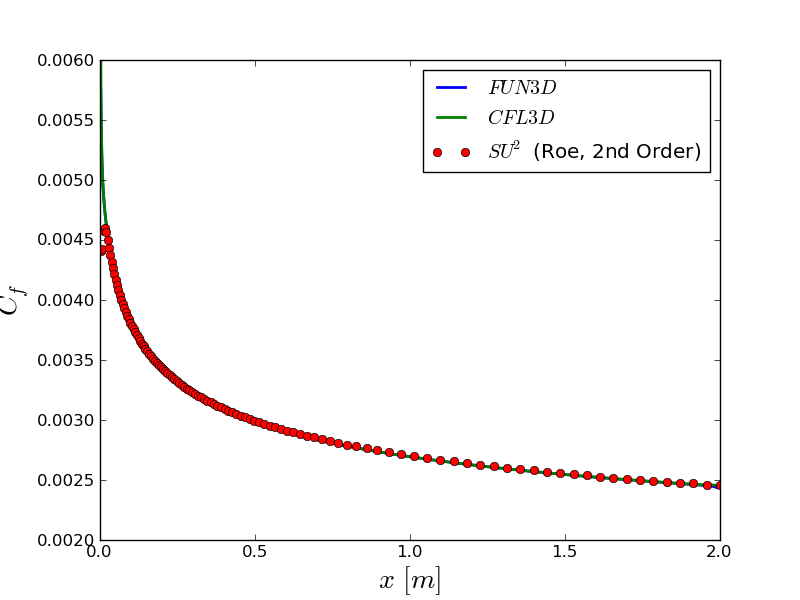-
Inviscid Bump in a Channel
Inviscid Supersonic Wedge
Inviscid ONERA M6
Laminar Flat Plate
Laminar Cylinder
Turbulent Flat Plate
Transitional Flat Plate
Transitional Flat Plate for T3A and T3A-
Turbulent ONERA M6
Unsteady NACA0012
Epistemic Uncertainty Quantification of RANS predictions of NACA 0012 airfoil
Non-ideal compressible flow in a supersonic nozzle
Aachen turbine stage with Mixing-plane
-
Inviscid Hydrofoil
Laminar Flat Plate with Heat Transfer
Turbulent Flat Plate
Turbulent NACA 0012
Laminar Backward-facing Step
Laminar Buoyancy-driven Cavity
Streamwise Periodic Flow
Species Transport
Composition-Dependent model for Species Transport equations
Unsteady von Karman vortex shedding
Turbulent Bend with wall functions
-
Static Fluid-Structure Interaction (FSI)
Dynamic Fluid-Structure Interaction (FSI) using the Python wrapper and a Nastran structural model
Static Conjugate Heat Transfer (CHT)
Unsteady Conjugate Heat Transfer
Solid-to-Solid Conjugate Heat Transfer with Contact Resistance
Incompressible, Laminar Combustion Simulation
-
Unconstrained shape design of a transonic inviscid airfoil at a cte. AoA
Constrained shape design of a transonic turbulent airfoil at a cte. CL
Constrained shape design of a transonic inviscid wing at a cte. CL
Shape Design With Multiple Objectives and Penalty Functions
Unsteady Shape Optimization NACA0012
Unconstrained shape design of a two way mixing channel
Adjoint design optimization of a turbulent 3D pipe bend
Turbulent Flat Plate
| Written by | for Version | Revised by | Revision date | Revised version |
|---|---|---|---|---|
| @economon | 7.0.0 | @talbring | 2020-03-03 | 7.0.2 |
Solver: |
|
Uses: |
|
Prerequisites: |
None |
Complexity: |
Basic |

Goals
Upon completing this tutorial, the user will be familiar with performing a simulation of external, turbulent flow over a flat plate. Consequently, the following capabilities of SU2 will be verified against other codes and theoretical results in this tutorial:
- Steady, 2D RANS Navier-Stokes equations
- Spalart-Allmaras turbulence model
- Roe convective scheme in space (2nd-order, upwind)
- Corrected average-of-gradients viscous scheme
- Euler implicit time integration
- Inlet, Outlet, and Navier-Stokes Wall boundary conditions
In this tutorial, we perform our first RANS simulation with the Spalart-Allmaras (SA) turbulence model.
Resources
The resources for this tutorial can be found in the compressible_flow/Turbulent_Flat_Plate directory in the tutorial website repository. You will need the configuration file (turb_SA_flatplate.cfg) and either of the two available mesh files (mesh_flatplate_turb_137x97.su2 or mesh_flatplate_turb_545x385.su2).
Additionally, skin friction and velocity profiles corresponding to this testcase (obtained from the Langley Research Center Turbulence Modeling Resource website shown below) are used for later comparison with SU2 results. These files can be found on the following website: http://turbmodels.larc.nasa.gov/flatplate.html.
Tutorial
The following tutorial will walk you through the steps required when solving for the turbulent flow over a flat plate using SU2. It is assumed you have already obtained and compiled the SU2_CFD code for a serial computation or both the SU2_CFD and SU2_SOL codes for a parallel computation. If you have yet to complete these requirements, please see the Download and Installation pages.
Background
Turbulent flow over a zero pressure gradient flat plate is a common test case for the verification of turbulence models in CFD solvers. The flow is everywhere turbulent and a boundary layer develops over the surface of the flat plate. The lack of separation or other more complex flow phenomena allows turbulence models to predict the flow with a high level of accuracy. Due to the choice of a low Mach number of 0.2 for this case, compressibility effects are essentially negligible.
For verification, we will be comparing SU2 results against those from the NASA codes FUN3D and CFL3D. We will also compare profiles of u+ vs. y+ against theoretical profiles of the viscous sublayer and log law region.
Problem Setup
The length of the flat plate is 2 meters, and it is represented by an adiabatic no-slip wall boundary condition. Also part of the domain is a symmetry plane located before the leading edge of the flat plate. Inlet and outlet boundary conditions are used on the left and right boundaries of the domain, and an outlet boundary condition is used over the top region of the domain, which is located 1 meter away from the flat plate. The Reynolds number based on a length of 1 meter is 5 million, and the Mach number is 0.2.
Mesh Description
The mesh used for this tutorial, which consists of 13,056 quadrilateral elements (the 137x97 grid), is shown below. A finer 545x385 grid file is also available. Additional grids for the flat plate in this same family can be obtained from the NASA Turbulence Modeling resource page.
 Figure (1): Mesh with boundary conditions: inlet (red), outlet (blue), symmetry (purple), wall (green).
Figure (1): Mesh with boundary conditions: inlet (red), outlet (blue), symmetry (purple), wall (green).
Configuration File Options
Several of the key configuration file options for this simulation are highlighted here. For the first time in the tutorials, we will use a turbulence model:
% ------------- DIRECT, ADJOINT, AND LINEARIZED PROBLEM DEFINITION ------------%
%
% Physical governing equations
SOLVER= RANS
%
% Specify turbulence model (NONE, SA, SA_NEG, SST)
KIND_TURB_MODEL= SA
The governing equations are first set to the Reynolds-averaged Navier-Stokes equations, and by entering KIND_TURB_MODEL= SA we activate the Spalart-Allmaras (SA) turbulence model. The SA model is a 1-equation model for a turbulence field variable that is directly related to the turbulent eddy viscosity. It is a popular choice for external aerodynamic flows, such as those around airfoils and wings. The SA Negative model (SA_NEG), other SA variants, and the Shear Stress Transport model (SST) of Menter are also available in SU2.
We must also specify suitable numerical methods for the solution of any additional turbulence equations:
% -------------------- TURBULENT NUMERICAL METHOD DEFINITION ------------------%
%
% Convective numerical method (SCALAR_UPWIND)
CONV_NUM_METHOD_TURB= SCALAR_UPWIND
%
% Monotonic Upwind Scheme for Conservation Laws (TVD) in the turbulence equations.
% Required for 2nd order upwind schemes (NO, YES)
MUSCL_TURB= NO
%
% Slope limiter (NONE, VENKATAKRISHNAN, VENKATAKRISHNAN_WANG,
% BARTH_JESPERSEN, VAN_ALBADA_EDGE)
SLOPE_LIMITER_TURB= VENKATAKRISHNAN
%
% Time discretization (EULER_IMPLICIT)
TIME_DISCRE_TURB= EULER_IMPLICIT
A scalar upwind method and the corrected average-of-gradients method are the default schemes for the turbulent convective and viscous fluxes, respectively. However, the user has the option to compute the convective flux to 1st-order (MUSCL_TURB= NO), 2nd-order (MUSCL_TURB= YES and SLOPE_LIMITER_TURB= NONE), or 2nd-order with slope limiting (MUSCL_TURB= YES and SLOPE_LIMITER_TURB chosen from an option other than NONE).
Running SU2
To run this test case, follow these steps at a terminal command line:
- Copy the config file (turb_SA_flatplate.cfg) and/or the mesh file (mesh_flatplate_turb_137x97.su2) so that they are in the same directory. Move to the directory containing the config file and the mesh file. Make sure that the SU2 tools were compiled, installed, and that their install location was added to your path.
-
Run the executable by entering
$ SU2_CFD turb_SA_flatplate.cfgat the command line.
- SU2 will print residual updates with each iteration of the flow solver, and the simulation will finish upon reaching the specified convergence criteria.
- Files containing the results will be written upon exiting SU2. The flow solution can be visualized in ParaView (.vtk) or Tecplot (.dat for ASCII).
Results
The figures below show results obtained from SU2 and compared to several results from NASA codes. Note that the SU2 results for the skin friction correspond to the coarser mesh (mesh_flatplate_turb_137x97.su2) while the NASA results are based on the finer mesh (mesh_flatplate_turb_545x385.su2). SU2 still matches very closely.
 Figure (2): Contour of turbulence variable (nu-hat).
Figure (2): Contour of turbulence variable (nu-hat).
 Figure (3): Profile for the skin friction coefficient.
Figure (3): Profile for the skin friction coefficient.
 Figure (4): Velocity profile comparison against law of the wall.
Figure (4): Velocity profile comparison against law of the wall.